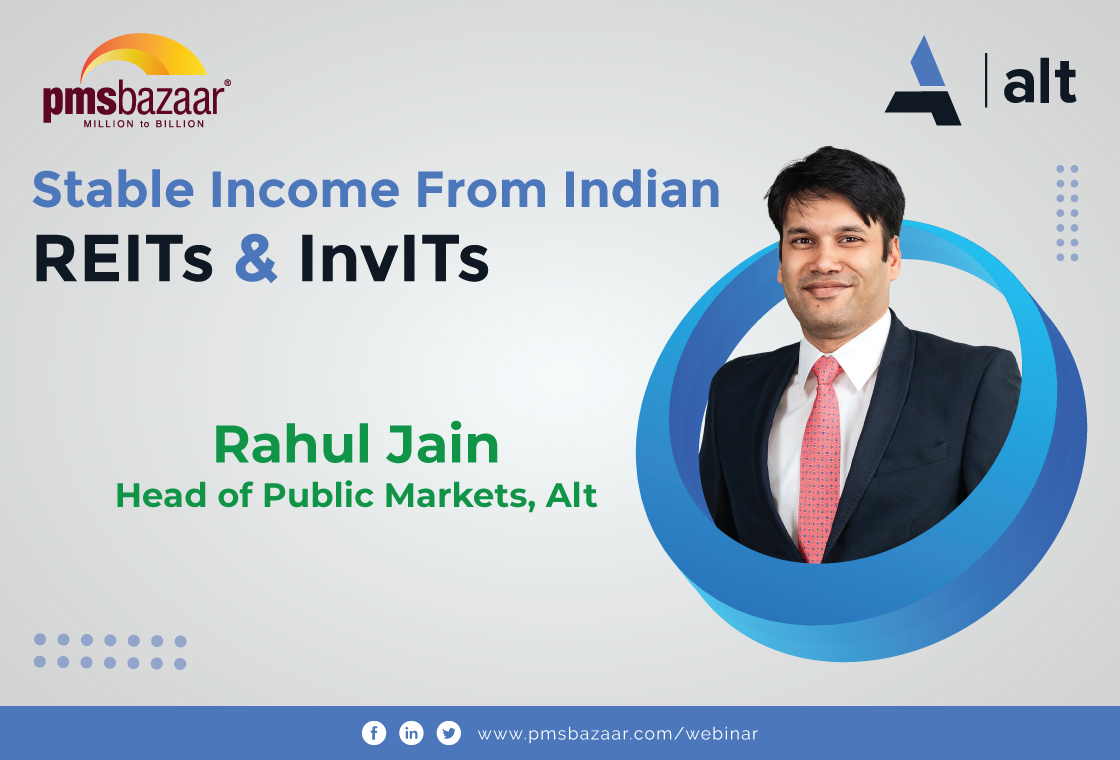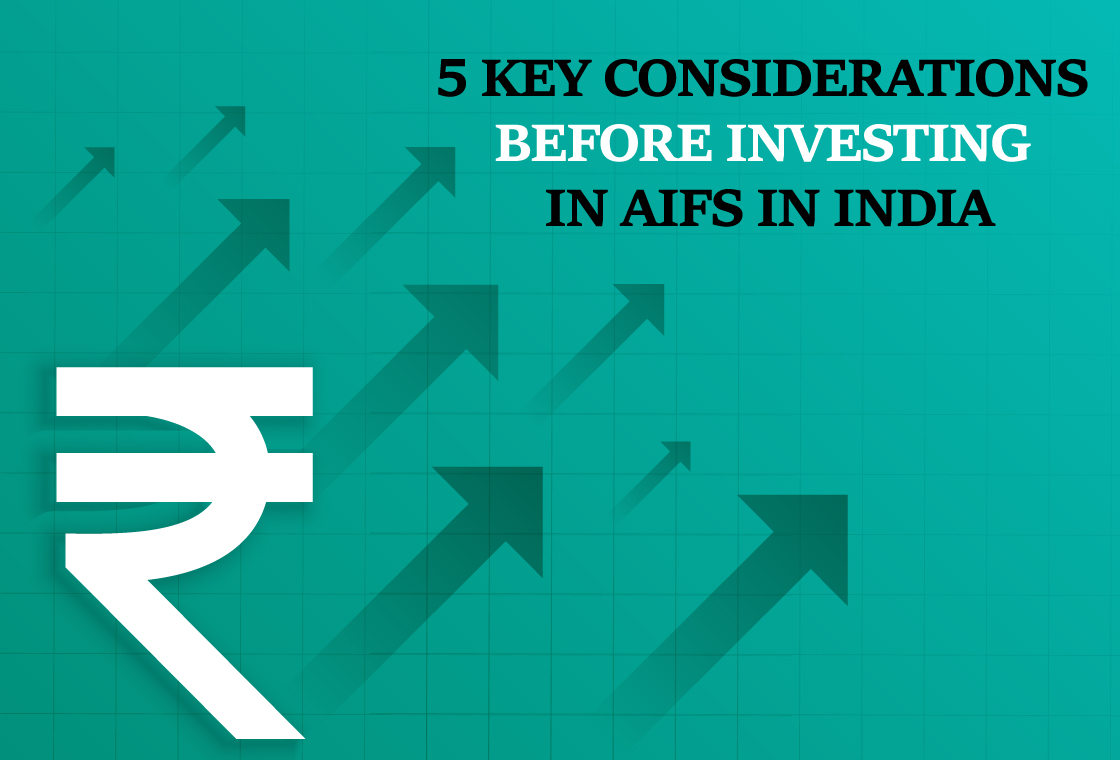COVID-19 risks are fading, and mobility data indicates a return to normal across many developed economies. The re-opening was meant to create a burst of activity in the first quarter of the year, followed by a more modest economic expansion. However, with the rising inflation, growth risks are to the downside, and the only certainty in public markets appears to be volatility. In such situations, alternative assets play a crucial role as they can enhance returns while minimizing downside risks of portfolios. This blog covers alternative investments that can deliver differentiated sources of return, diversify a portfolio, and serve as an inflation hedge, as well as, provide potential income.

PMS Bazaar recently held a webinar on the topic "Investing in Alternatives Through the Market Turmoil." The keynote speaker was Mr. Gaurav Mehta, CIO of SBI Fund Management. With historical statistics on the US government debt and Global money supply, he shared key insights of the past deflationary period with a lower growth rate and the current higher growth environment in the webinar session. In addition, he discussed the need for alternative investments.
Key insights covered in this webinar blog are -
- US Government Debt to GDP
- Indicators that show increase-decrease trends in inflation
- Depolarization check: Global context
- Rising nominal rates imply higher volatility across assets
1. US Government Debt to GDP
Today, there are two main challenges that global policymakers must deal with. The first is the issue of very high government debt. US debt has skyrocketed to about 120% plus as a result of the COVID crisis, which required the government to distribute benefits to households, which in turn caused a very significant increase in debt to GDP. Now that the ratio of government debt to GDP is so high, it is necessary to maintain real interest rates at historically low levels for extended periods of time to protect the government's ability to service its debt and reduce the debt to GDP ratio over time.
According to Mr. Gaurav, “Where government debt to GDP is so high, low-interest rates for a very long time, possibly even negative interest rates, as well as negative real rates, are necessary for this dynamic. As a result, real rates on an inflation-registered basis should be very low or negative,”
According to the U.S. CPI, the US is confronted with a massive increase in inflation over the last 25 years. Inflation is at a multi-decade high of 9%, forcing the US Fed to raise interest rates in a very sharp manner. Hence, you need low-interest rates otherwise government debt becomes unsustainable; on the other hand, high inflation is necessary, but with high-interest rates, the US is faced with significant policy challenges. The expectation is that inflation will eventually decline, allowing policy rates to return to normal. The United States in the 1940s saw a very significant increase in inflation, just as we are seeing now in the country. One reason for such inflation was that there was a lot of pent-up demand that led to a significant increase in demand and supply and the supply side could not match up. The dynamics are very similar to today, whereby demand–supply does not match.
There is a lot of one-time pent-up demand, but on the supply side, in some sectors like conventional energy, there won't be investments because of EAC (Electricity Advisor Committee) concerns over the last several years, logistics issues, and supply chain disruptions. So, supply and demand are not matching perfectly, and that is causing an increase in inflation.
But after that one-off surge in inflation that occurred in the US in the 1940s, there was a significant decline in inflation, which was partly caused by supply keeping up with demand. Second, because demand had already peaked and hence that pent-up demand came down and there was a significant moderation. Third, because inflation is an increase in prices year over year, once prices reach a plateau and remain there for a while, inflation inevitably decreases, since there will be no further increase in prices.
Therefore, considering the 1940 trends of inflation, there is a good chance that we will experience similar situations wherein demand from the US is now easing, supply disruptions are returning, and on top of all of this, there is this massive need to combat inflation. Hence, we could experience inflation like in the 1940s when a certain surge in inflation is followed by a decrease in inflation.
2. Indicators that show increase-decrease trends in inflation
The most crucial indicator to monitor for the global economy is the global money supply growth, which determines how much money is moving around in the economy globally.

If you look at this chart somewhere around the beginning of 2021, the money supply growth was very strong at 20%. However, if we see where things stand today, it's evident that there has been a significant decline, with money supply growth down to less than 4% from a peak of 20%. You can notice there is a very big drop in the growth of the global money supply, and this has happened even before, and the Fed has done nothing about it. The lowest point over the previous several years has been around 1-2% percent. Before the Fed started its tightening cycle and the balance sheet reduction was just about to start, there was a sizable decline, and there were two major causes that contributed to it.
One is the big slowdown in the Chinese economy. Two, the fact that fiscal policy in the U.S. is now not as stimulative as it was last unemployment and COVID-related checks that were being sent to US households stopped somewhere in September of last year (2021). This implies that there is already a weakening in money supply growth and now with the Fed intervening, there are chances there will be more decline in the money supply growth.
Now, what are the implications? To put it simply, if there is a lot of money moving around in the global economy, this causes nominal GDP growth, which causes more inflation and economic activity. On the other hand, if the amount of money moving around in the global economy sharply decreases, the exact opposite should occur, meaning that there should be less money moving around and less inflation and social economic activity.
In response to the above, Mr. Gaurav says, “I believe the implication for investors is that they must begin to live in a world where they shouldn't fixate with a fixed narrative because these narratives will frequently change, which will lead to volatility in both the markets and in policy because the Fed is currently hiking even though the government debt burden is so high because it must be seen as fighting inflation.’
3. Depolarization check: Global context
The volatility in macroeconomic indicators and at the policy level is something investors have to start to accept. The implication of this is which are the stocks that do well. To understand what types of stocks perform well in a deflationary environment, you should consider the following:

When you look back at the period between 2008 and 2020, you can see that it was a time when inflation was hardly discussed, there was little to no inflation, there was little to no global economic growth, and interest rates were almost at zero. This is what is known as a "perfect deflationary environment," where there is no growth, no inflation, and zero rates.
What works well in a deflationary environment is when interest rates are reduced, bonds do well but alongside bonds, a lot of assets that are bond-like in nature they also do very well. Moreover, in such situations, investors look at safety even with the equity investment. The classic example of that in the Indian context was that a lot of FMCG and quality stocks where cash flows are certain those stocks got massively rated and used to trade at a premium. They were trading from 20-30 times in 2009 to 60-70 times in 2020.
If investors see visibility on cash flows, they buy those stocks at any valuations. This wasn't just an Indian phenomenon; it was also true globally. For example, the valuations of big tech stocks or Nasdaq stocks just went through the roof. However, if you look at what's happened over the last 18 months, that narrative has completely changed.
The entire 12-year period between 2008 and 2020 where we saw deflation and low-interest rates led to a certain set of quality stocks being re-rated to stratospheric levels – this very clearly is history. Today, rates have started to rise and many of these valuations especially the ones that were very expensively valued are seeing a very significant derating in valuations. Therefore, we have completely moved from a deflationary environment to one where inflation is the key environment and the key theme. Even when inflation peaks and settles at a lower level, it's very likely that it will still be much higher than in the past decade. Similarly, there will be some growth slowdown in the near future, but again, that growth will be significantly better than in the last decade.
To sum up, you should expect quite a lot of volatility in macro data points and quite a lot of volatility in the policy. You should be ready for a significant style shift so what worked over the last 10 years may not necessarily work over the next 10 years, alongside, you should also expect heightened volatility in markets.
4. Rising nominal rates imply higher volatility across assets

The last 12 years, from 2008 to 20, were largely characterized by close to zero interest rates in the United States, and that also coincided with a period of very low NIFTY volatility. But if you go back to 2002 and 2008 those six years, you will see that interest rates in the US were constantly inching higher and alongside that NIFTY's volatility was also constantly inching higher.
If you look back in time to the 2002–2008 period, which is the best bull market for Indian equity markets ever, you will see that there was a lot of volatility. For example, between 2003 and 2008, there was one lower circuit on the indices every year, which meant that every day the index would halt trading because it was 10% down, and these were episodes where prices fell by as much as 50%. These episodes of 20 to 25 percent corrections and millions of small caps were frequent, much like the one we've witnessed over the past three to six months. In the end, it was a very rewarding period for investors who stayed invested since the NIFTY rose from 900 or 1000 to 6000.
If you look back to the decade from 2000 to 2010, when interest rates were low and volatility was high, index returns were strong because of high economic growth, which in turn led to high earnings growth and strong returns at the index level. However, because inflation was also rising at the time and interest rates were rising, volatility increased, leading to higher returns due to high volatility.
If you were to predict what will happen over the next three to five years, it looks very likely that we have transitioned from a deflationary regime into an inflationary regime. If anything, we should anticipate reasonable growth, but higher inflation and higher interest rates, which will allow equities to continue to provide positive end-to-end returns but with high volatility that will present challenges to stay invested in equities.
Mr. Gaurav Mehta covered all the above-mentioned topics in-depth and also answered some questions from the audience towards the end of the session. For more such insights on the subject, watch the recording of this insightful session through the appended link below:
Get access to rich data and analytics of PMS & AIF by subscribing to us. Join the 40000+ investors & experts now: Subscribe NOW
Recent Blogs
.jpg)
Passively Active Investing — A Modern Investor’s Lens on ETF-Based PMS
PMS Bazaar recently organized a webinar titled “Passively Active Investing — A Modern Investor’s Lens on ETF-Based PMS,” which featured Mr. Karan Bhatia, Co-Founder and Co-Fund Manager , Pricebridge Honeycomb ETF PMs. This blog covers the important points shared in this insightful webinar.

Spot the Trouble: Red Flags in Equity Investment Analysis
PMS Bazaar recently organized a webinar titled “Spot the Trouble: Red Flags in Equity Investment Analysis,” which featured Mr. Arpit Shah, Co-Founder & Director, Care Portfolio Managers. This blog covers the important points shared in this insightful webinar.

Long-Only AIFs Rebound Sharply in October; Long-Short Strategies Lag Despite Lower Volatility
106 long-only AIFs averaged 3.68% vs 32 long-short AIFs at 2.7%; only 24–31% of funds beat key indices

Markets log strongest monthly gains in 7 months; PMS performance turns near-uniform in October
Nifty 50 TRI gained 4.62%, BSE 500 TRI rose 4.27%; 415 of 427 equity PMSes ended positive

How SMEs are Shaping India’s Investment Landscape?
PMS Bazaar recently organized a webinar titled “How SMEs are Shaping India’s Investment Landscape?” which featured Mr. Shrikant Goyal, Fund Manager, GetFive Opportunity Fund.

Stable Income from Indian REITs and InvITs
PMS Bazaar recently organized a webinar titled “Stable Income from Indian REITs and InvITs,” which featured Mr. Rahul Jain, Head of Public Markets, Alt.

5 Key Considerations Before Investing in AIFs in India
Alternative Investment Funds (AIFs) have emerged as a compelling option for sophisticated investors seeking diversification and potentially superior returns. But venturing into AIFs requires a clear understanding of their unique characteristics that go beyond simply knowing what they are and their categories.

How AIF can help in diversification?
Traditionally, Indian investors have relied on a mix of stocks and bonds to build their wealth. While this approach offers diversification, it can still leave your portfolio vulnerable to market fluctuations. Enter Alternative Investment Funds (AIFs), a dynamic asset class gaining traction for its ability to unlock diversification beyond the realm of conventional options.

